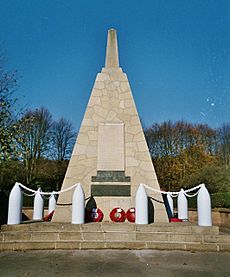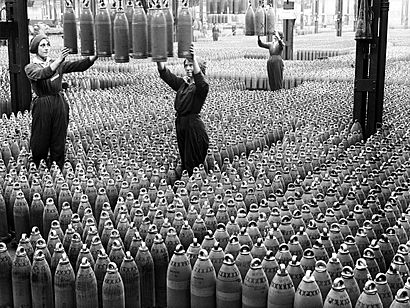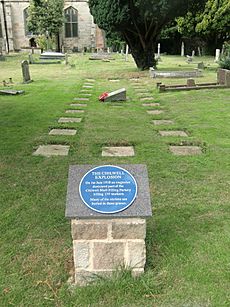National Shell Filling Factory, Chilwell facts for kids
The National Shell Filling Factory, Chilwell was a very important factory in the United Kingdom during World War I. It was owned by the government and its main job was to fill shells with explosives. It was also known as National Filling Factory No. 6.
The factory was located near a small village called Chilwell in Nottinghamshire. It was on the main road between Nottingham and Ashby de la Zouch. During World War I, this factory filled about 19 million shells with powerful explosives.
Contents
Why the Factory Was Built
The Chilwell factory was built because of something called the Shell Crisis of 1915. This was when Britain realized it didn't have enough shells for its soldiers fighting in the war.
At first, shells were filled with an explosive called Lyddite. But the materials needed for Lyddite had to be brought in from other countries. So, the army decided to use trinitrotoluene (TNT) instead. TNT was hard to make and there wasn't much of it. Because of this, they started using a mix called Amatol, which was made from TNT and Ammonium nitrate.
On August 20, 1915, a man named Godfrey Chetwynd, 8th Viscount Chetwynd was put in charge. His job was to design, build, and run a factory that could fill large shells with Amatol. He asked Albert Hall, an engineer from Ferranti, to be his chief engineer. The Chilwell area was chosen because it was near a railway line, which made it easy to bring materials in. Also, hills around the site helped to protect the area.
From the very beginning, women were hired to work at the factory. This might have been another reason why Chilwell was chosen, as women in nearby towns often worked in textile factories. Working with the explosives sometimes turned the women's skin yellow. Because of this, they were known as the "Chilwell Canaries" or "Canary Girls."
The Big Explosion of 1918
A large part of the factory was destroyed on July 1, 1918, when about eight tons of TNT exploded. This terrible event killed 134 people. Only 32 of them could be clearly identified. Another 250 people were hurt. The bodies that couldn't be identified were buried together in a mass grave at St. Mary's Church, Attenborough. People said the sound of the explosion could be heard up to twenty miles away!
Even after such a huge disaster, the factory workers showed amazing courage. They returned to work the very next day to continue helping the war effort. In fact, within a month of the explosion, the factory reached its highest weekly production ever!
Winston Churchill, who was the Minister of Munitions at the time, sent a telegram to the factory. He praised their bravery and spirit. He said that those who died had "died at their stations on the field of duty." He also admired their decision to keep working without a break, comparing it to the spirit of soldiers. The King also sent a telegram from Buckingham Palace.
Because of the factory's bravery and quick return to work, some people suggested it should receive the Victoria Cross, which is a very high military honor. While it didn't officially get this award, the site became known as "The V.C. Factory." Lieutenant Arthur Hilary Bristowe, the works manager, was given the Edward Medal for his heroic actions after the explosion.
Police from Scotland Yard investigated the explosion. Some thought it might have been sabotage, meaning someone purposely caused it. However, it's more likely that the accident happened because of relaxed safety rules. Workers were trying very hard to meet high production goals, and the TNT itself might have become unstable on a warm day.
At the time, newspapers only reported it as "60 feared dead in Midlands factory explosion" to avoid causing panic during the war.
On November 16, 1918, the factory's band, which Lord Chetwynd had started, played music at Buckingham Palace. They then marched to Downing Street and played outside the Prime Minister's home. The Prime Minister, David Lloyd George, congratulated them. They also played outside the Ministry of Munitions.
Remembering the Factory and Its Workers

A special memorial was built to remember everyone who died in explosions at the factory. It was officially revealed on March 13, 1919, by the Duke of Portland. The memorial is a tall, thin stone pillar called an obelisk on top of a large pyramid-shaped base.
It has an inscription that not only remembers the dead but also shares some interesting facts about the factory's achievements:
- The factory started being built on September 13, 1915.
- The first shell was filled on January 8, 1916.
- Within one year of starting, 1,260,000 shells were filled.
- In total, the factory filled 19,359,000 shells. This was more than half of all the high-explosive shells made in Great Britain during the war!
- They used 121,360 tons of explosive.
- The total weight of all the filled shells was 1,100,000 tons.
On the 50th anniversary of the explosion in 1968, the memorial was fixed up. New plaques were added to honor those who died in both World Wars.
After World War I ended in 1919, the factory site became a storage place for the Royal Army Ordnance Corps. Today, it is known as Chetwynd Barracks, which is a military base. The memorial itself became a protected historic building in 1988.
For the 100th anniversary of the explosion in 2018, the mass grave at Attenborough Church was updated. A new memorial was put in place, designed by soldiers from the Royal Engineers. It looks like a simplified Celtic cross made of special steel, with a sword on top. This new memorial is similar to an old wooden cross that used to be on the grave but was lost. The grave was rededicated on July 1, 2018.
See also
- Munitionette (woman working in a filling factory)
- National Filling Factory, Georgetown (NFF No 4, in Scotland)
- List of the largest artificial non-nuclear explosions



